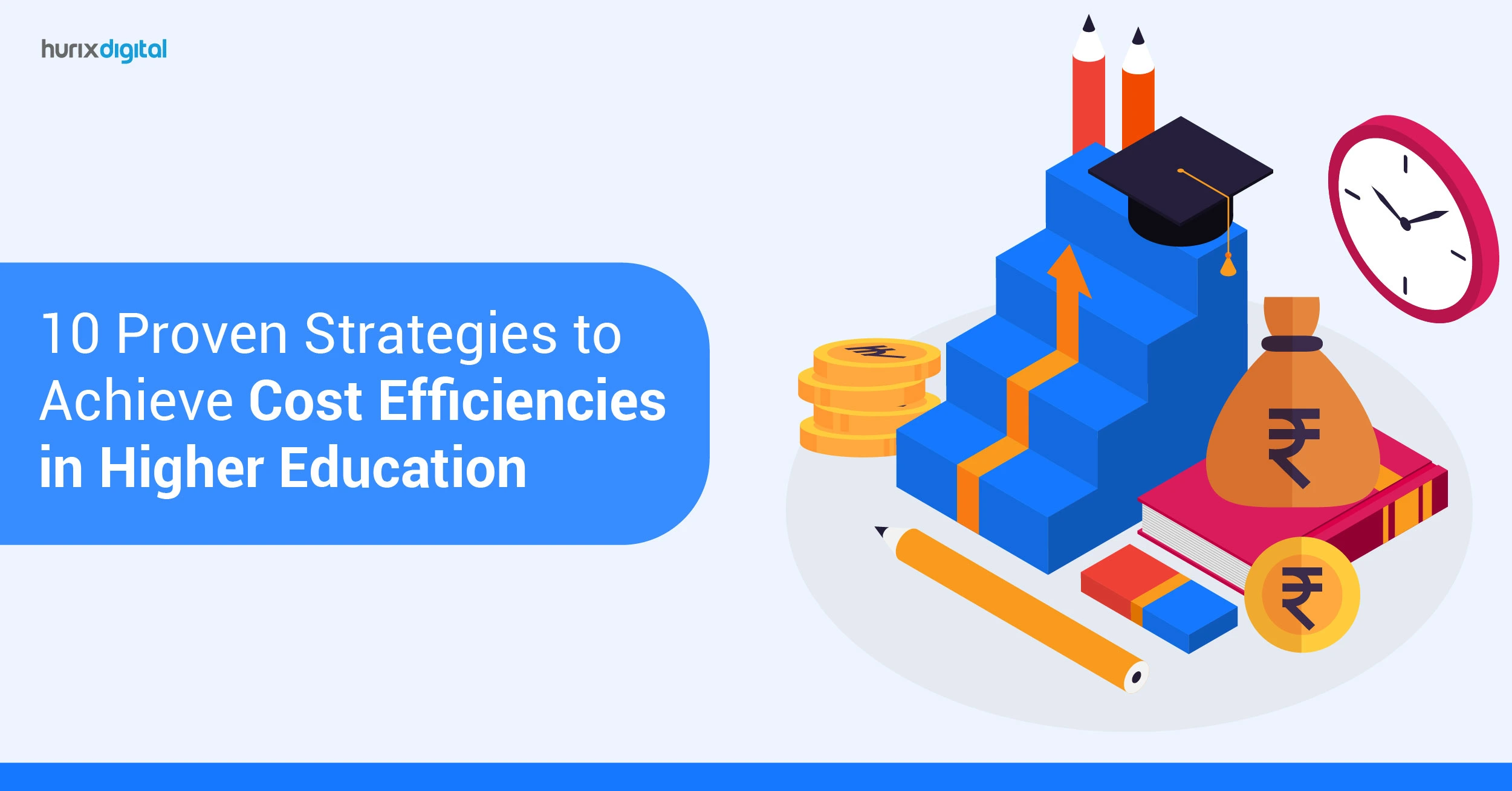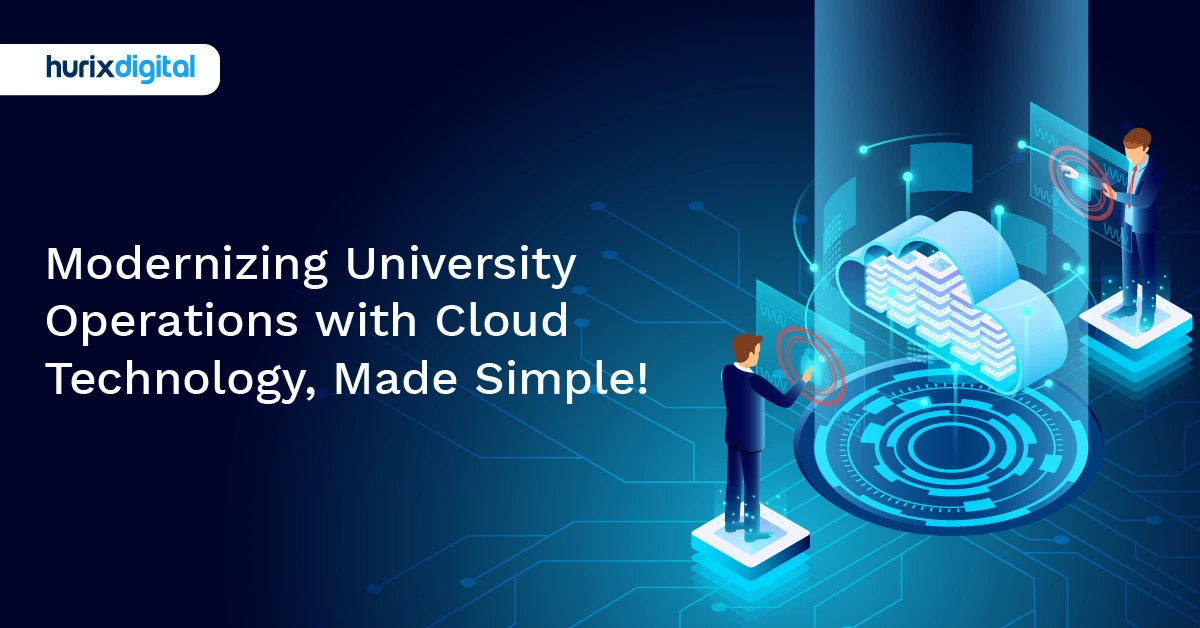
10 Proven Strategies to Achieve Cost Efficiencies in Higher Education
Summarize with:
Higher education institutions face mounting challenges in maintaining financial sustainability due to rising costs, fluctuating enrollment trends, and shifting demographics. This calls for a strategic reimagining of cost structures and operations to foster resilience.
Institutions that adopt proactive measures during economic shifts are better equipped to enhance their financial stability and uphold the quality of education. Read on as we explore ten proven strategies to transform higher education spending and achieve cost efficiency.
Table of Contents:
10 Strategies to Reduce Higher Ed Costs
From talent management and administrative workflows to academic affairs, technology, and facilities, institutions must adopt a comprehensive approach to optimizing resource allocation and financial performance.
Here are some strategies that provide a solid foundation for optimizing an institution’s monetary health:
1. Leverage Technology
Strategic digital transformation significantly enhances operational efficiency and cost efficiencies in higher education. By implementing robust digital solutions, institutions can streamline administrative processes, reducing the reliance on paper-based systems and manual tasks.
Furthermore, the development and growth of online and hybrid learning programs can enhance the efficient use of resources, minimize the requirements for infrastructure investments, and extend the range of educational offerings.
In addition, data analytics gives institutions valuable data on their issues, delivers cost savings, and makes informed decisions on institutional management, resource consumption, and overall effectiveness.
Also Read: Role of Technology in Higher Education Curriculum Development
2. Optimize Staffing
Staffing is essential to denote the employment of the most appropriate and efficient human resources to drive the cost-efficient agenda in college and university settings.
In this case, workforce planning can be used to maintain an organized database of staffing requirements so that a particular institute can avoid mistakes like overstaffing and inefficient resource allocation.
One benefit is that cross-training staff means equipping them with multiple skills, thus increasing flexibility and avoiding exclusive recruiting. In addition, outsourced services like IT, human resources, and finance include freeing the institution to concentrate more on core activities since general flexible services can be contracted.
3. Consolidate Operations
Simplification of processes means the unification of related operations to minimize the number of administrative centers and enhance the effective use of resources.
Since opportunities for merging or consolidating departments can be established, institutions can improve processes, reduce the number of existing duplicates, and economize on administrative expenses.
Some benefits organizations achieve by centralizing functions, including procurement, human resources, and technology, are cost savings, efficiency, and quality service delivery. In addition, when undertaking a space audit, property owners can spot empty areas and campus layouts and do away with the related expenses.
4. Reduce Energy Costs
Energy savings is one of the best approaches to university budget optimization. By covering various areas with efficient lights, heating, ventilation, and air conditioning systems, as well as efficient building automation systems, institutions can control energy consumption and operating expenses.
Moreover, it is possible to expand the use of renewable energy sources, particularly solar power, to reduce the occurrences of relying on conventional energy and introducing negative impacts on the environment.
Aimable energy savings strategies, which include developing programs that motivate faculty, staff, and students to adopt energy-conserving behaviors, will also go a long way in reducing energy costs while reaching for practicing sustainable practices.
5. Streamline Procurement
Efficiency, especially in sourcing and acquisition of materials, is critical to achieving cost optimization and overall effectiveness of operations in learning institutions.
Financial managers indicate that procurement functions can lower costs through economies of scale, institutional buying power, and administrative expenses through consolidation and using their collective buying power to negotiate favorable contracts with suppliers.
A subsequent level is using e-procurement systems, where buying activity can be made even more efficient, transparent, and controlled. Promoting sustainable procurement point solutions, like supplier environmental ratings, can decrease an institution’s ecological footprint alongside costs in the long run.
6. Enhance Financial Aid Management
Effective disbursement is a fundamental function that must be well-coordinated and efficient in its delivery of service to students as well as management of resources.
In return, various institutions can tremendously minimize frustrations, enhance time efficiency on administrative tasks, and streamline financial aid applications and distributions by incorporating automated systems.
There are additional ways in which efficient processes and technology solutions can continue to lower cost components related to financial aid and translate more financial resources into student service efforts on campuses.
Adhering to federal regulations is crucial for institutions, as they form the basis of federal funding, which can boost institutional funding and student aid.
7. Diversify Revenue Streams
Expanding funding resources is a realistic model for developing financial security for higher education institutions. It is thus crucial to look for diversification of revenues: income sources other than tuition fees, including corporate benefactions, license revenues, and real estate income.
Engaging the faculty can enhance annual and overall giving, which can go hand in hand with increasing endowments and assuming predictable revenue sources. Executive education programs can be a source of ROI in higher education, boosting the institution’s popularity and allowing faculty members to interact with industry leaders.
8. Foster Partnerships
This includes developing strategic partnerships to cultivate institutional competitiveness and innovation. Through collaborative engagement, institutions can share resources, reduce costs, and design new, innovative academic programs.
It allows partnering with industrial leaders who would open possibilities for research, internships, and curriculum development aimed at aligning students’ skills with workforce requirements.
Engagement with the local community extends collaboration opportunities for mutual benefits, such as undertaking joint research, community outreach programs, and workforce development.
9. Continuous Improvement
Culture change should embrace improvement programs that enable business improvement and sustained cost efficiencies in higher education.
By developing KPIs, institutions can monitor performance, learn of potential shortcomings, and evaluate efficiency. Thus, data analytics enables leaders in institutions to work smarter by allowing them to use data to direct resources to bear projects that will have the most significant impact.
Monthly and annual check-ups of financial status and organizational performance facilitate the detection of typical trends of operational ailments and on-time corrective actions that help institutions keep the most favorable financial health and perfect organizational performance standards.
10. Student-Centered Approach
A student-centered approach is essential for improving student outcomes and institutional effectiveness. By implementing personalized learning strategies, institutions can tailor instruction to meet the unique needs of each student, enhancing engagement and retention.
Robust mentorship programs can provide students with guidance, support, and encouragement, fostering a sense of belonging and increasing their likelihood of success. Comprehensive career services can help students develop essential skills, explore career opportunities, and secure employment upon graduation, reducing time-to-degree and improving overall student satisfaction.
Also Read: Enhancing Global Competitiveness through Innovative Educational Solutions
Final Words
As higher education institutions navigate an era of fiscal constraint, leaders are compelled to scrutinize every facet of their operations to identify opportunities for cost reduction and efficiency enhancement.
Strategies for cutting costs are important, but so is looking for opportunities to generate revenue. In the interim, cutting costs can protect vital resources, expedite procedures, and maintain the institution’s ability to provide students with top-notch educational opportunities.
Hurix Digital offers a comprehensive suite of solutions to streamline operations, enhance efficiency, and drive cost savings. Our experts develop engaging online courses to expand your reach and accommodate diverse learner needs while our digital solutions reduce administrative overhead and improve efficiency. Feel free to reach out for further info.
Summarize with:

Senior Vice President – Business Development
at Hurix Digital, with over 25 years of experience in EdTech and workforce learning. He excels in business development, customer relationship management, and scaling digital learning solutions, driving global growth through innovative content, simulations, and AI‑driven training offerings
 A Space for Thoughtful
A Space for Thoughtful 




